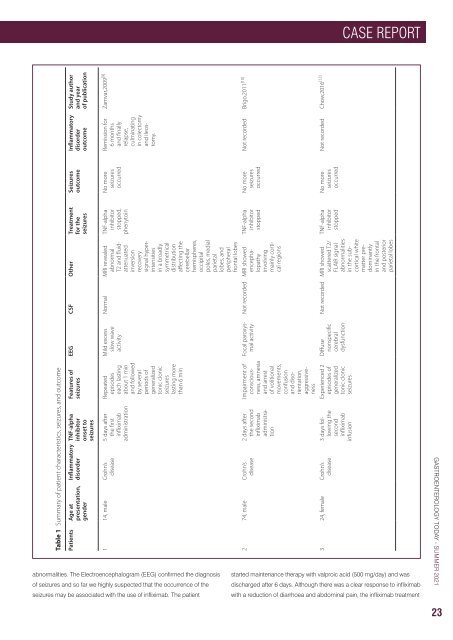Gastroenterology Today Summer 2021
Gastroenterology Today Summer 2021
Gastroenterology Today Summer 2021
You also want an ePaper? Increase the reach of your titles
YUMPU automatically turns print PDFs into web optimized ePapers that Google loves.
CASE REPORT<br />
Table 1 Summary of patient characteristics, seizures, and outcome<br />
Features of<br />
seizures<br />
TNF-alpha<br />
inhibitor<br />
onset to<br />
seizures<br />
Inflammatory<br />
disorder<br />
Patients Age at<br />
presentation,<br />
gender<br />
EEG CSF Other Treatment<br />
for the<br />
seizures<br />
Seizures<br />
outcome<br />
Inflammatory<br />
disorder<br />
outcome<br />
Repeated<br />
episodes<br />
each lasting<br />
about 1 min<br />
and followed<br />
by several<br />
periods of<br />
generalized<br />
tonic clonic<br />
seizures<br />
lasting more<br />
than 6 min<br />
Mild excess<br />
slow wave<br />
activity<br />
Focal paroxysmal<br />
activity<br />
Normal MRI revealed<br />
abnormal<br />
T2 and fluidattenuated<br />
inversion<br />
recovery<br />
signal hyperintensities<br />
in a broadly<br />
symmetrical<br />
distribution<br />
affecting the<br />
cerebellar<br />
hemispheres,<br />
occipital<br />
poles, medial<br />
parietal<br />
lobes, and<br />
peripheral<br />
frontal lobes<br />
Not recorded MRI showed<br />
encephalopathy<br />
involving<br />
mainly cortical<br />
regions<br />
TNF-alpha<br />
inhibitor<br />
stopped,<br />
phenytoin<br />
5 days after<br />
the first<br />
infliximab<br />
administration<br />
TNF-alpha<br />
inhibitor<br />
stopped<br />
1 14, male Crohn’s<br />
disease<br />
Diffuse<br />
nonspecific<br />
cerebral<br />
dysfunction<br />
Not recorded MRI showed<br />
scattered T2/<br />
FLAIR signal<br />
abnormalities<br />
in the subcortical<br />
white<br />
matter predominantly<br />
in the frontal<br />
and posterior<br />
parietal lobes<br />
TNF-alpha<br />
inhibitor<br />
stopped<br />
No more<br />
seizures<br />
occurred<br />
No more<br />
seizures<br />
occurred<br />
No more<br />
seizures<br />
occurred<br />
Study author<br />
and year<br />
of publication<br />
Remission for<br />
6 months<br />
and finally<br />
relapse,<br />
culminating<br />
in colectomy<br />
and ileostomy.<br />
Zamvar,2009 [9]<br />
Not recorded Brigo,2011 [10]<br />
Not recorded Chow,2016 [12]<br />
abnormalities. The Electroencephalogram (EEG) confirmed the diagnosis<br />
of seizures and so far we highly suspected that the occurrence of the<br />
seizures may be associated with the use of infliximab. The patient<br />
Impairment of<br />
consciousness,<br />
amnesia<br />
and arrest<br />
of volitional<br />
movements,<br />
confusion<br />
and disorientation,<br />
aggressiveness<br />
2 days after<br />
the second<br />
infliximab<br />
administration<br />
2 74, male Crohn’s<br />
disease<br />
Experienced 2<br />
episodes of<br />
generalized<br />
tonic clonic<br />
seizures<br />
3 days following<br />
the<br />
second<br />
infliximab<br />
infusion<br />
3 24, female Crohn’s<br />
disease<br />
started maintenance therapy with valproic acid (500 mg/day) and was<br />
discharged after 6 days. Although there was a clear response to infliximab<br />
with a reduction of diarrhoea and abdominal pain, the infliximab treatment<br />
GASTROENTEROLOGY TODAY - SUMMER <strong>2021</strong><br />
23

















